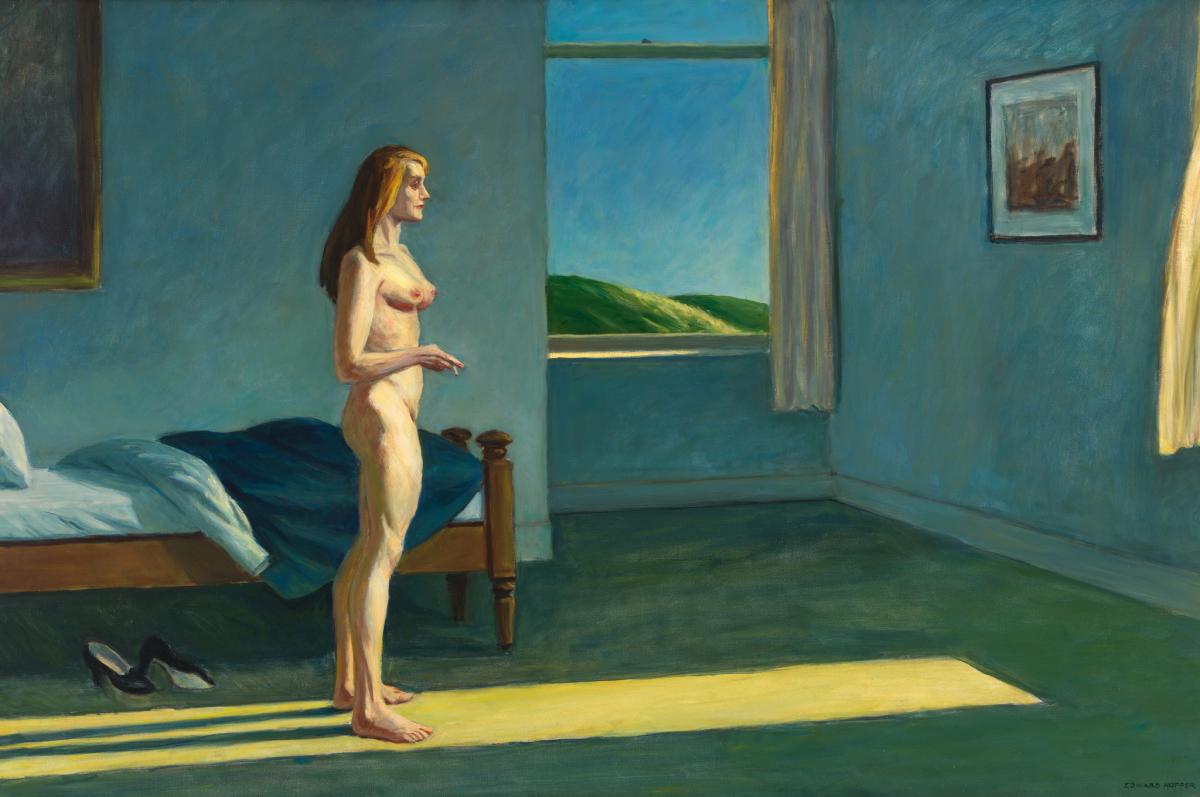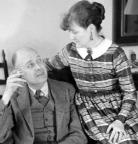Life in Solitude
Created by Ian Meyers on Mon, 03/25/2024 - 12:56
This timeline provides sociohistorical context behind Edward Hopper’s piece A Woman in the Sun from 1961. This piece depicts a naked woman inside of a fairly barren room, solemnly bathing in the sunlight pouring in from the window.

Hopper, Edward. “Edward Hopper: A Woman in the Sun.” Edward Hopper | A Woman in the Sun | Whitney Museum of American Art, whitney.org/collection/works/1337. Accessed 25 Mar. 2024.
Timeline
Chronological table
| Date | Event | Created by | Associated Places | |
|---|---|---|---|---|
| 1942 |
World War II and NighthawksTo start with looking at Edward Hopper as an artist would be a logical first step when understanding some context behind Woman in the Sun. Many of you are probably familiar with Hopper’s Nighthawks, as it is one of his most popular works. The painting features a depiction of a sparsely populated diner at night, with unlit streets surrounding it. Hopper painted this roughly around two decades prior to the piece that we are looking at. And what was happening two decades before 1961? That would be World War II. The solitude portrayed in Hopper’s Nighthawks is absolutely intentional, as it shows New York City amidst the war. The emptiness of the image tells us that many people are away, fighting in a war and those that are left could perhaps be feeling some uncertainty in the world, as this was painted in the earlier stages of the war. The ideas provoked by Nighthawks are familiar, but unnerving. The city streets, even at night, should be bustling with some activity, but they are not. Of course, a painting as well-known today as Nighthawks didn’t fly under the radar. People were drawn to this painting and related to its depiction of isolation and hopelessness during wartime. It stuck with people. Because of this critical reception to this piece – and even prior to Nighthawks – Hopper knew that he had a talent for capturing this lonely vibe of the environment around him. World War II itself was something that affected everyone, and this was Hopper’s way of expressing that. It is also important to note that Hopper already had a name for himself at this time; he was popular and known in the art world, consistently providing works such as Nighthawks. |
Ian Meyers | ||
| circa. 1952 |
Edward Hopper's Sketches of Josephine HopperNow that we have talked a bit about the artist himself, let’s move on to a very important part of his life and work, which would be his wife. The woman in Woman in the Sun is not an unknown figure, it is Josephine Hopper. If you look at a Hopper piece that depicts people, like Woman in the Sun, chances are, his wife Josephine modeled for those people. Now we may assume that because she modeled for him, we could say their marriage was happy. But this would just be a straight up lie. It was very tumultuous and oftentimes violent. Despite this, one thing to note is that they stayed together until Edward Hopper’s death. Not only that, but they had one very important thing in common, which is that they both painted. However, because of this, Jo found herself almost fading into irrelevance after their marriage, as Ed got all of the fame with pieces such as Nighthawks. This undoubtedly caused some friction in a relationship between two very different people; they were very divergent personality-wise. The quiet Ed would often get into intense verbal exchanges with his more assertive wife. A great window into this marriage would be sketches that Edward Hopper did of their arguments. He would leave these sketches out for Jo to look at and attempt to get a rise out of her. An example of one of these sketches shows Ed sitting in a recliner silently as an angry Jo is yelling at him for something. The caption below reads “he cannot choose but hear.” Although these sketches give us only one point of view, it is more than enough evidence to prove that it was a rocky relationship. |
Ian Meyers | ||
| circa. 1960 |
The Rise of Abstract ExpressionismLeading up to the completion of A Woman in the Sun, it would make sense to take a look at the art world as a whole. Hopper’s works are undoubtedly examples of realism, works that sent him into being a well-known name in the art scene. But by 1960, not only was Edward Hopper in his late 70s, but more avant-garde, daring artists were coming onto the canvas and seemed to be stealing the spotlight. When I say avant-garde, I begin to think of someone like Clyfford Still, who was creating at around the same time as Hopper. Still’s 1957-D-No. 1 is the exact opposite of something that Hopper would create. There are no realistic people or settings in the piece; it is rather a hodgepodge of colors thrown onto the canvas. The unorthodox style even extends to the title of the piece. Instead of describing what is in the painting – which in this case would more than likely just be colors – he titles it something like 1957-D-No. 1. This is not to discredit Still or other avant-garde artists, but it is important to understand that this was slowly becoming Hopper’s competition near the end of his life. After years of painting realistic scenes, canvases of irregular color patterns were beginning to overshadow the public eye. The rise of abstract expressionism, art that falls into the avant-garde category, is an important thing to take into account when looking at A Woman in the Sun. Hopper was not only older, but also found himself fading into a realm of irrelevancy. |
Ian Meyers | ||
| 1 Apr 2024 |
The Docent StoryAll of these events contribute to the eventual completion of A Woman in the Sun in 1961. In turn, these events are key to understanding an analysis of the painting. To begin with Hopper’s Nighthawks, a work that dealt him a hand of great fame, he clearly knew of his own talent when depicting feelings of solitude. We can draw similarities between it and A Woman in the Sun. Very little light is shown in both pieces. Our central subjects are surrounded by an unnerving darkness, or at the very least, cooler colors. The vacant street in Nighthawks and the vacant room in Woman in the Sun speak to this isolation interpretation of both. What light is there is featured on the subjects of the respective paintings, highlighting them and, in turn, their feelings. This is where we can turn to the two people directly responsible for Woman in the Sun; Edward and Josephine Hopper themselves. As I mentioned before, their marriage was rough. Not only was it rough, but it was hard in general because their personalities did not necessarily mesh well. We can see this through Ed’s sketches of Jo alone; rather than talking to his wife about the basis behind the argument, he does a cheeky sketch for her to potentially start another argument. This lack of communication in any relationship, romantic or not, leads to feelings of isolation. In this case, it is fair to say that the artist, Ed, had feelings of isolation regarding this marriage, as did the subject, Jo. This is part of the point behind the feelings of solitude behind this painting; the unfulfilling marriage, which at this point, had lasted for nearly forty years. To draw on Edward Hopper himself a tad more, to help us understand this painting, we can revisit the rise of abstract expressionism during the latter years of his life. While Hopper’s realism still had its place, abstract expressionism was rearing its head in more and more as the years went by. Hopper saw his style being phased out and felt discouraged in the art world, a world which he dominated in the decades prior, with Nighthawks and other works. Some sources say that his wife did indeed need to help him out of depressive bouts of apathy towards art. This is, ultimately, what A Woman in the Sun comes down to...it is a commentary of Edward Hopper himself. It is the mental space of an older man, just mere years away from death, based on events derived from his own life; his unfruitful marriage and his once popular of artform slowly dwindling in the favor of a more experimental style. MLA Citations “Clyfford Still - 1957-D-No. 1.” Buffalo AKG Art Museum, 2 Oct. 2016, buffaloakg.org/artworks/k195926-1957-d-no-1. Hopper, Edward. “Edward Hopper: A Woman in the Sun.” Edward Hopper | A Woman in the Sun | Whitney Museum of American Art, whitney.org/collection/works/1337. Accessed 25 Mar. 2024. Lynge, Claire. “A Woman in the Sun: Josephine Nivison Hopper.” Confluence, NYU Gallatin, 21 Feb. 2023, confluence.gallatin.nyu.edu/context/first-year-writing-seminar/a-woman-in-the-sun-josephine-nivison-hopper. May, Stephen. “Scenes from Edward Hopper’s Marriage.” ARTnews.Com, ARTnews.com, 10 Mar. 2014, www.artnews.com/art-news/news/scenes-from-edward-hoppers-marriage-2390/. McColl, Sarah. “Jo Hopper, Woman in the Sun.” The Paris Review, 26 Feb. 2018, www.theparisreview.org/blog/2018/02/26/jo-hopper-woman-sun-woman-shadow/. Murphy, Jessica. “Edward Hopper (1882–1967).” The Met, 1 June 2007, www.metmuseum.org/toah/hd/hopp/hd_hopp.htm. Sidelnikova, Yevheniia. “Love Story in Paintings: Edward Hopper and Josephine Nivison.” Arthive, Artsmarts, 12 Sept. 2020, arthive.com/publications/4409~Love_story_in_paintings_edward_hopper_and_josephine_nivison. Zappella, Christine. “Wartime Alienation, Hopper’s Nighthawks.” Smarthistory, 24 Sept. 2018, smarthistory.org/seeing-america-2/nighthawks-sa/. |
Ian Meyers |




